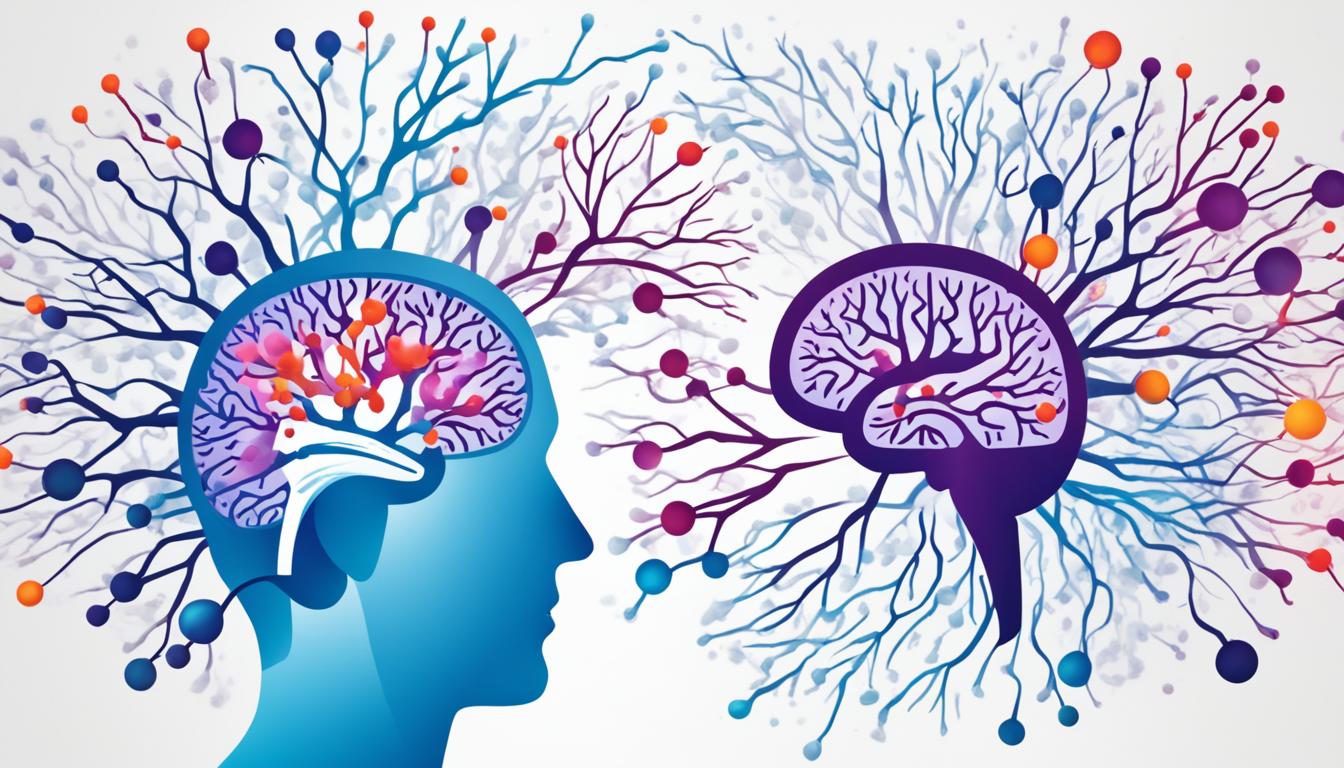Frontal lobe epilepsy is a common type that starts in the front part of the brain. It affects around 1.2% of people in the United States. It’s the second most seen focal epilepsy. Causes often include head injuries, stroke, and infections of the nervous system.
The first treatment step is usually with drugs. Doctors prescribe antiepileptic drugs (AEDs) to control the seizures. Surgery might be an option if the seizures come from a specific spot in the frontal lobe. This surgery takes out the area causing the problem. Stimulating parts of the brain is also a method used to lower the number of seizures. Besides, there’s hope in stem cell research for treating this epilepsy.
Key Takeaways:
- Frontal lobe epilepsy affects about 1.2% of the U.S. population.
- Possible causes are head injuries, stroke, and certain infections.
- Treatments can involve drugs, diet changes, surgery, and newer stem cell techniques.
- Doctors often use antiepileptic drugs to help control seizures.
- In some cases, surgery might remove the source of the seizures.
- Neuromodulation therapy aims to lessen the frequency of seizures.
- Stem cell treatments are being explored but more studies are necessary.
Frontal Lobe Epilepsy Symptoms
Frontal lobe epilepsy comes with many symptoms. These can differ from person to person. It all depends on where the seizures start in the frontal lobe. Knowing and spotting these symptoms early is very important for treating the condition well.
Some usual symptoms are:
- Seizures on one side of the body
- Stiffness or twitches
- Feeling a “wave” go through the head
- Being unresponsive or not fully present
- Accidentally urinating
People with this type of epilepsy usually have the same symptoms during their seizures. But if they start having different symptoms, it could mean their condition is changing. Any new or unusual symptoms need to be checked by a doctor. This is extremely important.
Seizures can be triggered by many things. These triggers can include stress, not getting enough sleep, feeling tired, being hungry, drinking alcohol, doing drugs, and even missing medication doses.
Not all these triggers affect everyone the same way. But in general, avoiding these triggers as much as possible can help lessen the number and severity of seizures. Also, getting the right diagnosis and treating the seizures correctly can really improve the life of someone with this type of epilepsy.
Frontal Lobe Epilepsy Diagnosis
To diagnose frontal lobe epilepsy, several things must happen:
| Diagnostic Tests | Description |
|---|---|
| Electroencephalogram (EEG) | It checks the brain’s electricity. This helps spot unusual patterns linked to seizures. |
| Magnetic Resonance Imaging (MRI) | It shows very clear brain images. This helps find any issues that might be causing the seizures. |
| Video EEG Monitoring | This records videos and brain data together. It’s great for seeing and understanding seizure events. |
| Neuropsychological Testing | This checks brain functions. It looks for any problems caused by frontal lobe epilepsy. |
Getting the right diagnosis is key. It helps doctors choose the best treatment. This way, people with frontal lobe epilepsy can manage their condition better.
Frontal Lobe Epilepsy Treatment
Dealing with frontal lobe epilepsy often needs many types of help. This can include using antiepileptic drugs (AEDs), surgery, therapy that changes the way the brain works, changing what you eat, and getting help from others with epilepsy.
Antiepileptic Drugs (AEDs)
Doctors might give you drugs like oxcarbazepine to control seizures. These drugs help steady the brain’s electric signals, making seizures less frequent and severe. AEDs work well for about 70% of people who have epilepsy.
Epilepsy Surgery
If medicine doesn’t stop your seizures, surgery could be an option. Doctors might remove the brain tissue causing the seizures. This operation can greatly lower how many seizures you have or even stop them altogether.
Neuromodulation Therapy
For those not helped by drugs or surgery, neuromodulation is another way forward. It uses special devices to send small electrical signals to your brain. This can help calm down parts of your brain that are too active, reducing seizures.
Dietary Changes
Changes in your diet can also be a big help. A ketogenic diet, which is high in fats and low in carbs, has eased seizures for some. It might be a good choice if drugs aren’t working for you.
Epilepsy Support
Having epilepsy can be tough, but support is out there. Talking to a counselor or joining a support group can make a big difference. They offer advice, understanding, and the chance to meet people in the same situation.
In the end, treating frontal lobe epilepsy means using different strategies. The main goal is to make seizures happen less often and with less impact on your life. With the right care and support, managing this condition is possible.
Stem Cell Therapy for Frontal Lobe Epilepsy
Stem cell therapy shows great promise in treating frontal lobe epilepsy. Studies highlight that transplanting human neural stem cells can lessen sudden seizures in animals with epilepsy. This breakthrough could mean better ways to manage or stop seizures altogether.
More research and trials are needed to confirm the safety and success of stem cell therapy. But, results so far hint at a breakthrough in tackling epilepsy. Stem cells can become different cell types, such as neurons, key for brain functions. By replacing or fixing damaged cells in the frontal lobe, this therapy aims to help the brain work better and reduce seizures.
The future of epilepsy treatment may change significantly because of stem cell therapy. It targets epilepsy’s cause, not just its symptoms. With ongoing progress, this approach could offer lasting improvements for seizure control and life quality for epilepsy patients.

